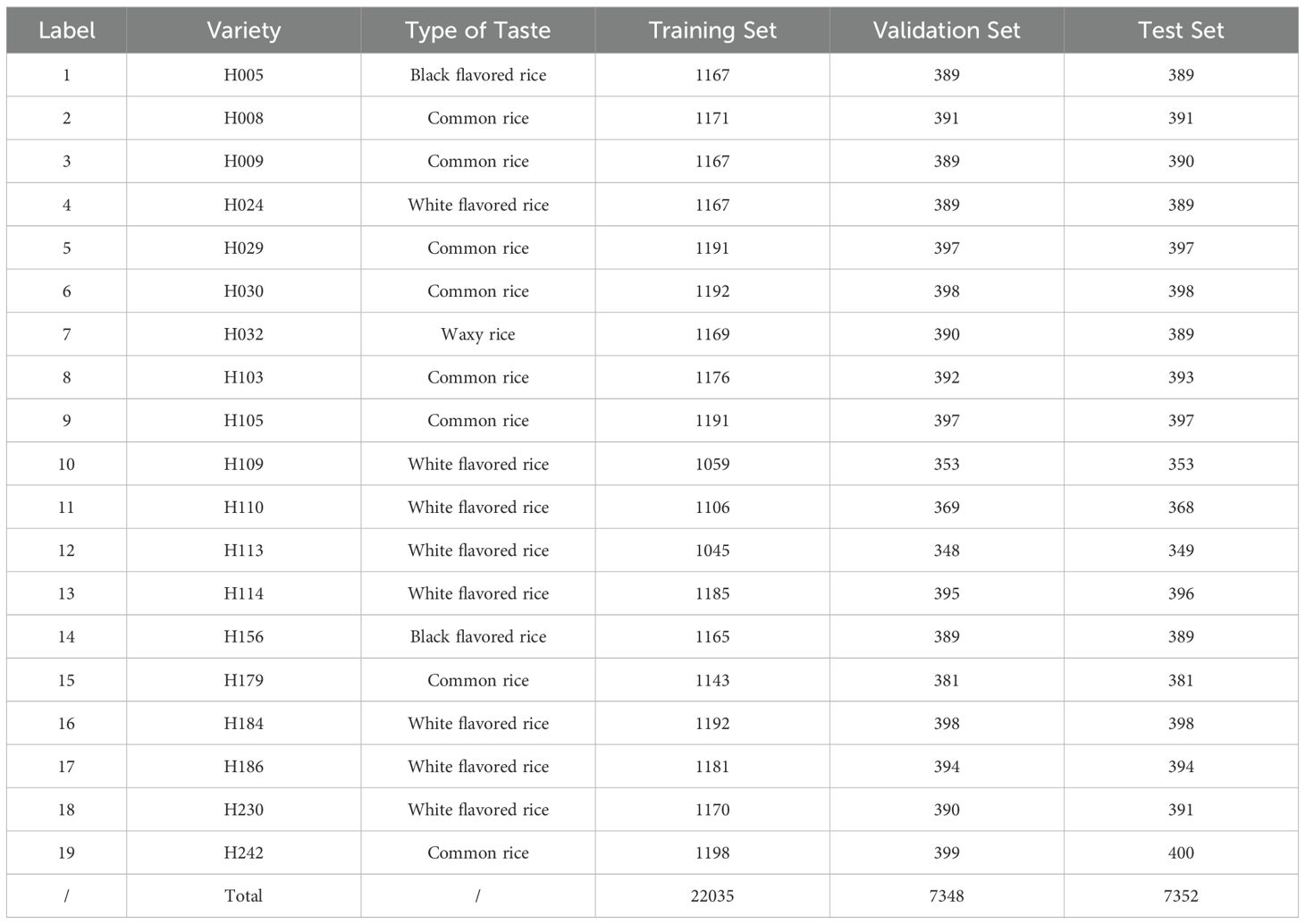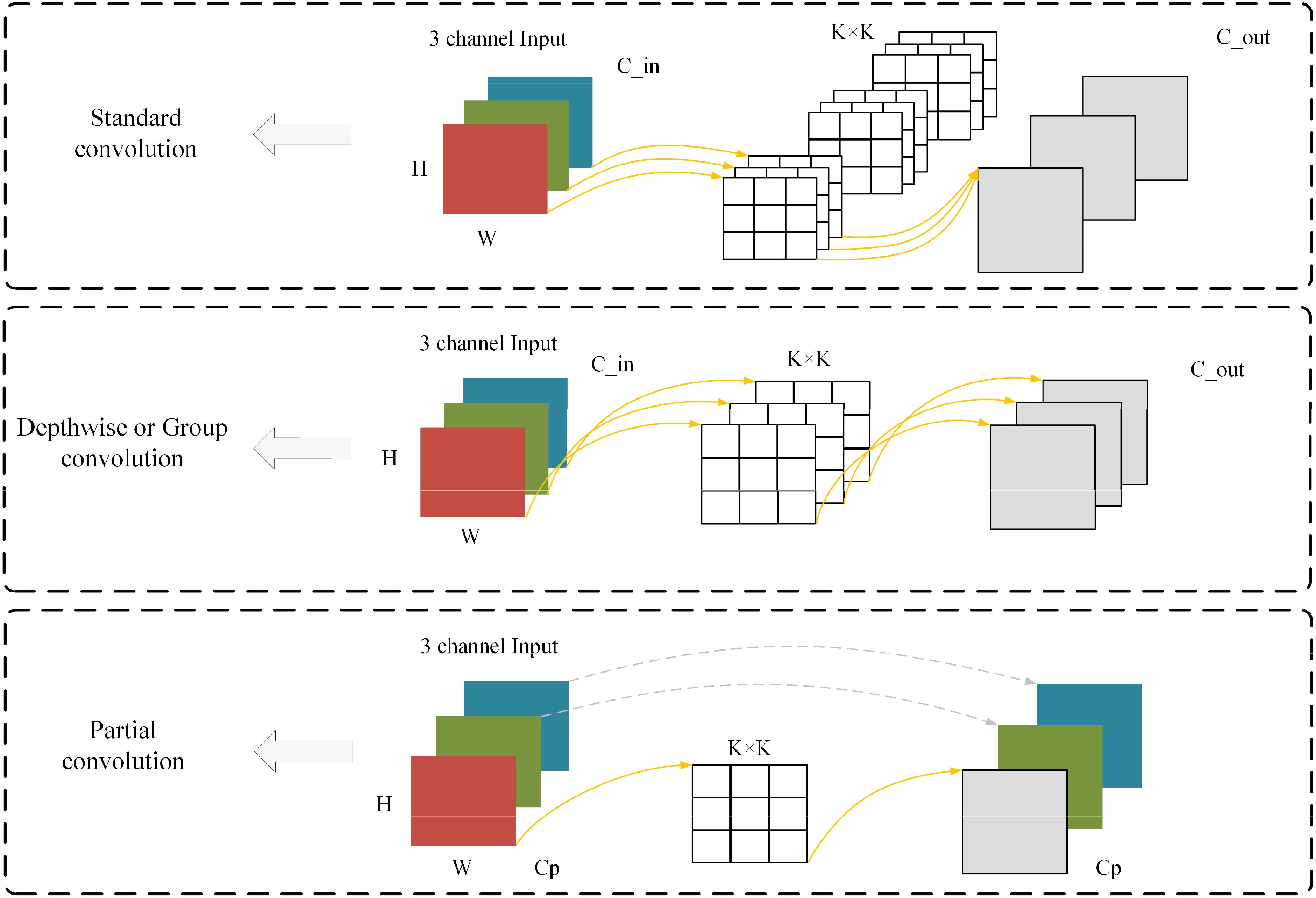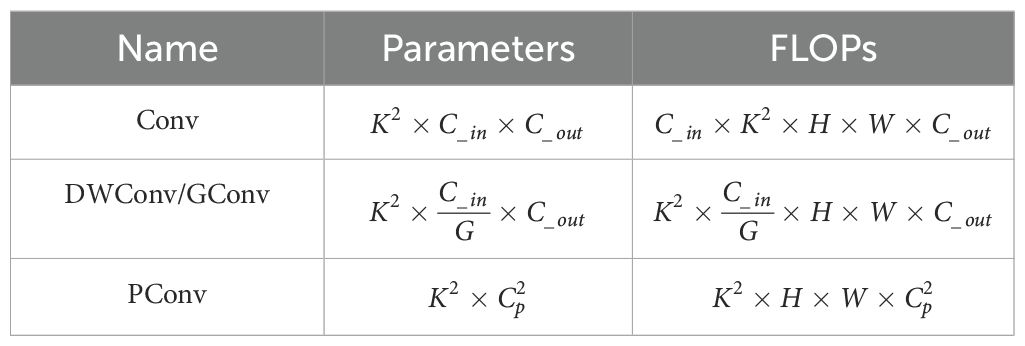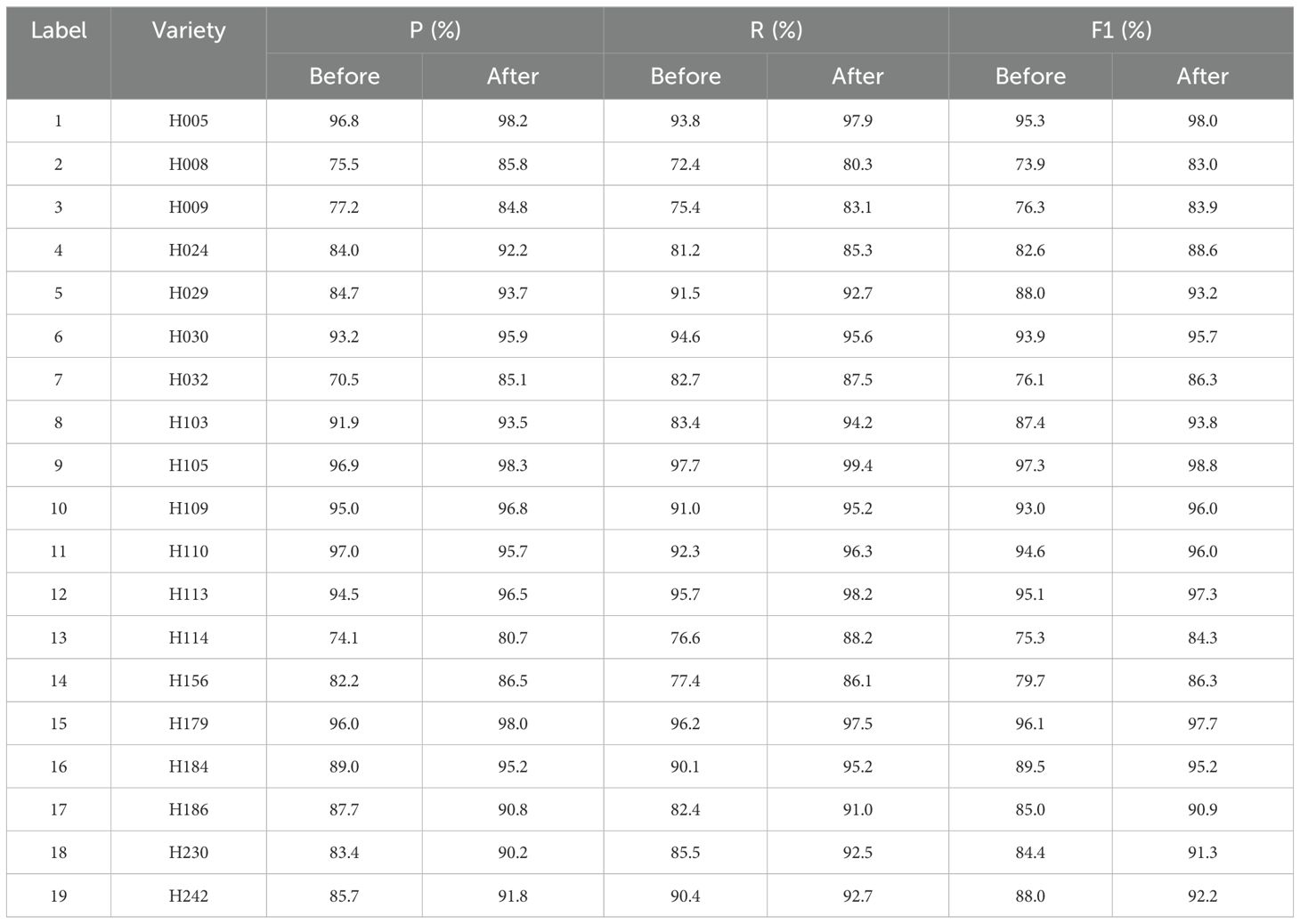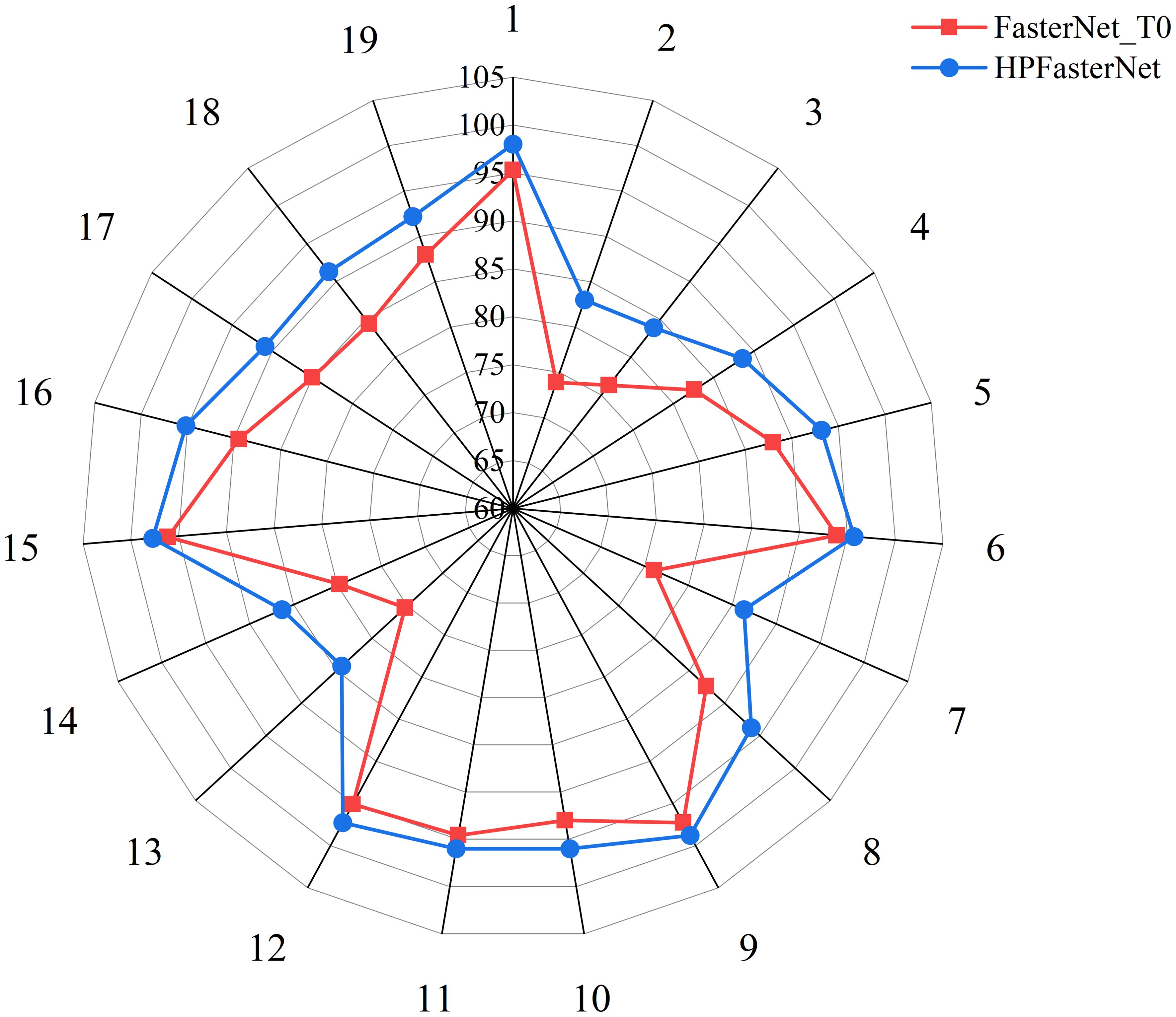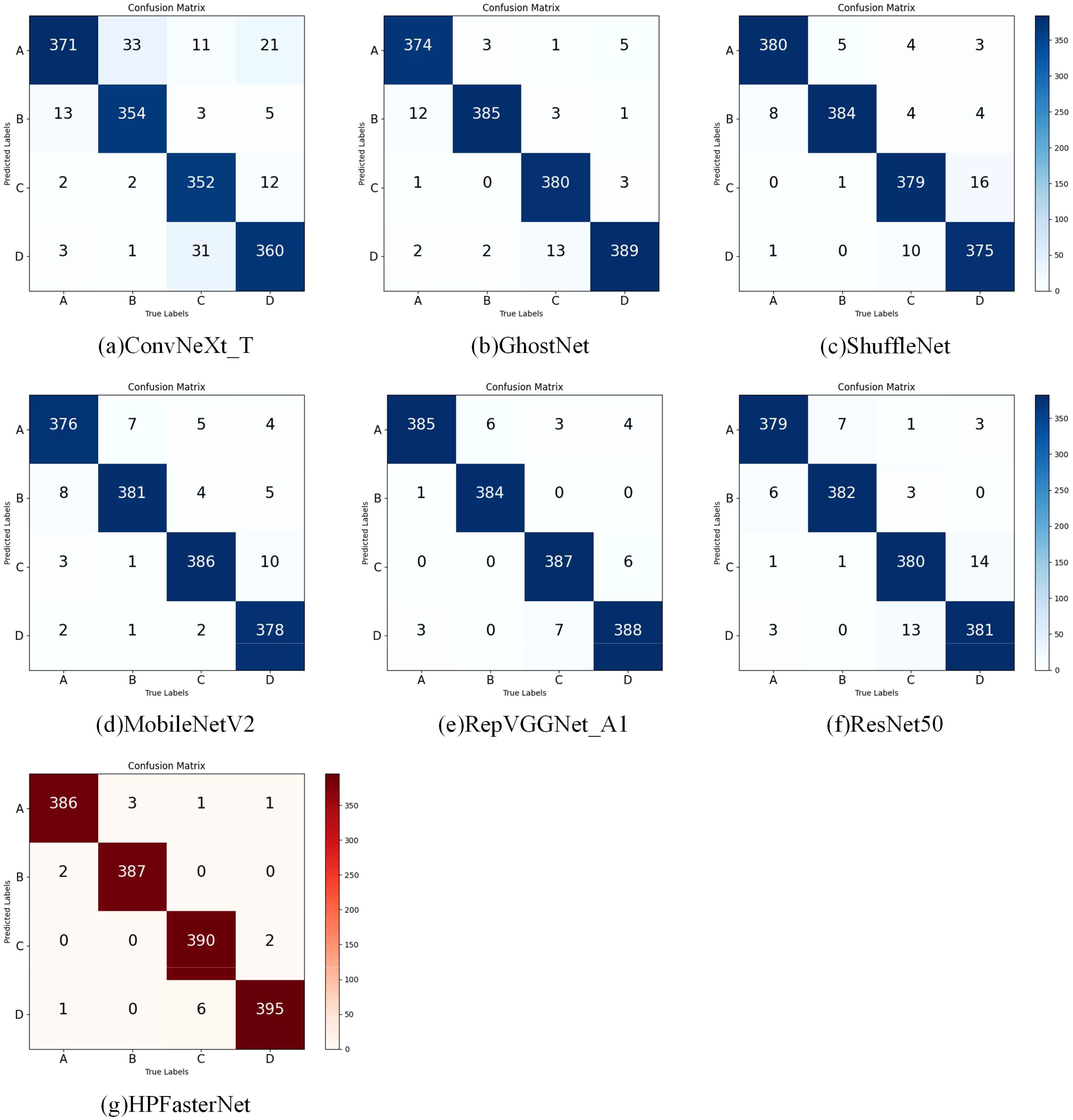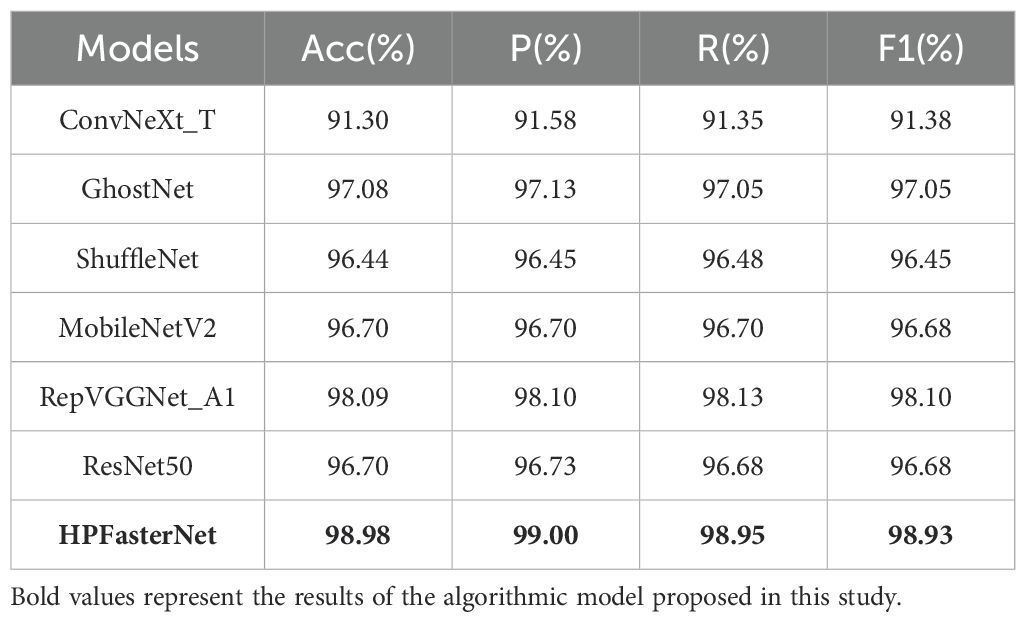- 1Smart Agriculture Research Institute, Jilin Agricultural University, Changchun, China
- 2College of Information Technology, Jilin Agricultural University, Changchun, China
- 3School of Data Science and Artificial Intelligence, Jilin Engineering Normal University, Changchun, China
- 4Rice Research Institute, Jilin Academy of Agricultural Sciences, Changchun, China
Rice is an important part of the food supply, its different varieties in terms of quality, flavor, nutritional value, and other aspects of the differences, directly affect the subsequent yield and economic benefits. However, traditional rice identification methods are time-consuming, inefficient, and prone to damage. For this reason, this study proposes a deep learning-based method to classify and identify rice with different flavors in a fast and non-destructive way. In this experiment, 19 categories of japonica rice seeds were selected, and a total of 36735 images were finally obtained. The lightweight network High Precision FasterNet (HPFasterNet) proposed in this study combines the Ghost bottleneck and FasterNet_T0 and introduces group convolution to compare the model performance. The results show that HPFasterNet has the highest classification accuracy of 92%, which is 5.22% better than the original model FasterNet_T0, and the number of parameters and computation is significantly reduced compared to the original model, which is more suitable for resource-limited environments. Comparison with three classical models and three lightweight models shows that HPFasterNet exhibits a more comprehensive and integrated performance. Meanwhile, in this study, HPFasterNet was used to test rice with different flavors, and the accuracy reached 98.98%. The experimental results show that the network model proposed in this study can be used to provide auxiliary experiments for rice breeding and can also be applied to consumer and food industries.
1 Introduction
As the staple food for nearly half of the world’s population, rice provides a rich source of nutrients (Verma and Srivastav, 2020), and its yield and quality are important for global food security, soil conservation, and genetic diversity (Verma et al., 2021). There are significant differences in the quality of different varieties of rice, and these differences are mainly affected by natural factors such as climate, soil, and water, as well as by human factors such as planting technology and variety selection (Lu et al., 2019). Generally speaking, rice with good quality is more likely to be favored by the market, thus bringing higher economic benefits (Creppy et al., 2024). In many countries, the production and sale of seeds have been commercialized, with huge economic profits lurking (Qaim, 2020). Poor-quality rice is often exploited by unscrupulous traders to counterfeit high-quality varieties on the market for higher profits. However, traditional methods of rice variety identification are often time-consuming, expensive, and usually only available for small batches (Koklu et al., 2021a). Computer vision and deep learning are popular for being non-contact, non-destructive, and inexpensive, which can automatically extract the features of rice images, quickly process a large amount of data, and realize accurate classification through algorithmic models, which significantly improves the classification efficiency and accuracy (Zareiforoush et al., 2015). Therefore, the appearance characteristics of rice seeds are crucial to the accuracy of computer vision recognition (Patrício and Rieder, 2018).
In the past, many scholars have conducted related research. Yufei Ge’s team proposed a real publicly available benchmark dataset for the classification of rice seed hyper-spectral imaging systems. Meanwhile, they proposed a difficulty-weighted k-nearest neighbor-based algorithm, IDKNN, for the hyperspectral classification of rice seeds and achieved very excellent results (Ge et al., 2024). Baichuan Jin’s team, on the other hand, utilized NIR hyperspectral imaging in combination with deep learning to successfully differentiate between different varieties of rice seeds, in particular, they employed NIR-HSI with LeNet, GoogLeNet and residual network (ResNet) models for recognition, among which, the ResNet model has the best classification effect, and the classification accuracy of the test set reaches 86.08% (Jin et al., 2022). Deepa Joshi’s team achieved the label-free and lossless classification of rice seeds by deep neural network and optical coherence tomography with a good classification effect (Joshi et al., 2021). Hengnian Qi’s team utilized near-infrared hyperspectral imaging for the detection of rice seed viability and combined it with a transfer learning method to achieve significant results. They used the CNN model of Yongyou 12 constructed with MixStyle migration knowledge to classify the vigor of Yongyou 1540, Su Xiang Japonica 100, and Long Japonica 1212, and the accuracy reached 90.00%, 80.33%, and 85.00%, respectively, which was an excellent performance (Qi et al., 2023). Jinfeng Zhao’s team utilized the rotationally aware deep learning model YOLO-rot to measure the size of rice seeds and achieved remarkable results (Zhao et al., 2023). Chunguang Bi and other scholars proposed a seed classification model based on the Swin Transformer, which utilizes the self-attention mechanism to effectively extract image information, focuses on feature attention and multi-scale feature fusion learning, and demonstrates accurate and efficient ability to classify seeds. The MFSwin Transformer model achieved a remarkable average accuracy, recall, and F1 score of 96.53%, 96.46%, and 96.47%, respectively, on the test set with a parameter count of 12.83 M (Bi et al., 2022). Murat Koklu’s team developed a non-destructive model to improve the classification success rate by utilizing images of rice varieties for classification. In this model, they extracted 106 morphological and color features from rice images as inputs to artificial neural networks and DNNs and successfully performed classification (Koklu et al., 2021b). Helong Yu (Yu et al., 2024) proposed an improved residual network method based on the characteristics of rice to effectively classify rice seeds of the same variety grown in different regions, and the accuracy of the proposed model reaches 95.13%, which is an improvement of 7.56% to the original model and achieves very good results. Hongwei Li (Li et al., 2024) proposed and disclosed a dataset of dragon fruit, which was captured under different conditions, including multiple angles, different lighting conditions, and different weather conditions. The proposed enhanced YOLOv5s model exhibits an impressive 97.80% average accuracy and achieves an impressive 139 frames per second (FPS) in a GPU running environment. Compared to current state-of-the-art models, the improved YOLOv5 performs well and demonstrates the preferred level of overall performance. Mingyou Chen (Chen et al., 2024) proposed a set of vision algorithms for motion destination estimation, real-time self-localization and dynamic harvesting. In addition, a solid coordination mechanism for continuous motion and harvesting behavior is established. Each method has unique advantages, such as improving accuracy, adapting to different conditions, improving harvesting efficiency, enabling autonomous continuous operation of the robot, and validating the rationality of the methods in comprehensive field trials. To sum up, research in hyperspectral and near-infrared spectroscopy is costly and inefficient, making it difficult to realize large-scale applications. In addition, the performance of related studies based on deep learning models may decline when confronted with more rice varieties, and numerous scholars may not be able to balance the accuracy of the model and the parameters of the model itself.
In response to the above problem, this study proposes a fast, lossless, and inexpensive lightweight network to categorize different varieties of rice seeds. In the area of deep learning, standard convolution (Conv) has strong expressive ability and accuracy, and its strong expressive ability and accuracy are its core advantages (Cong and Zhou, 2023). However, since each convolutional kernel needs to learn multiple weight values and there is no shared weight between different convolutional kernels, the number of parameters of Conv is usually large (Tulbure et al., 2022). In this study, FasterNet (Chen et al., 2023) is chosen as an improved model mainly because FasterNet significantly reduces redundant computations and memory accesses by introducing the new technique of partial convolution (PConv), which makes FasterNet run very fast on a wide range of devices while maintaining a high level of accuracy. The Ghost module in GhostNet (Han et al., 2020)generates a large number of ghost feature maps through cheap operations and then undergoes a small number of conventional convolutions, thus enlarging the width of the network and improving the feature representation capability without increasing the computational effort.
1. The research content and methods of this paper include:
Nineteen varieties of flavored rice seeds were collected and their RGB images were acquired. The images of individual rice seeds were obtained by image segmentation.
2. Combining Ghost bottleneck (Han et al., 2020) with FasterNet (Chen et al., 2023) while introducing group convolution to get HPFasterNet. A learning rate dynamic adjustment strategy is introduced during model training. Compared with the original model, HPFasterNet is more accurate, more efficient, and less weighted.
3. Evaluate the classification performance of the model and compare it with ResNet50 (He et al., 2016; Xie et al., 2017), ConvNeXt_T (Liu et al., 2022), RepVggNet_A1 (Ding et al., 2021), GhostNet (Han et al., 2020), ShuffleNet (Zhang et al., 2018) and MobileNetV2 (Sandler et al., 2018) models, respectively.
4. The changes in the results before and after the improvement were analyzed and the test results of four different flavored rice were analyzed using the improved model.
2 Materials and methods
2.1 Sample collection and preprocessing
All samples in this study were obtained from the Rice Research Institute of Jilin Academy of Agricultural Sciences, China. The sample for the study consisted of 19 varieties of japonica rice. The imaging system is shown in Figure 1A and consists of a NikonD7100 camera and a lens, a light control system controlling two lights, and at the bottom, a carrier for the seeds, which is wrapped in a black light-absorbing cloth and then shot vertically by the camera. During data collection, 200 rice seeds of the same variety were first randomly selected and arranged in a 10 × 20 grinding apparatus. Then, without seeds overlapping or sticking, they were inverted on a black cloth and their RGB images were acquired by the camera.
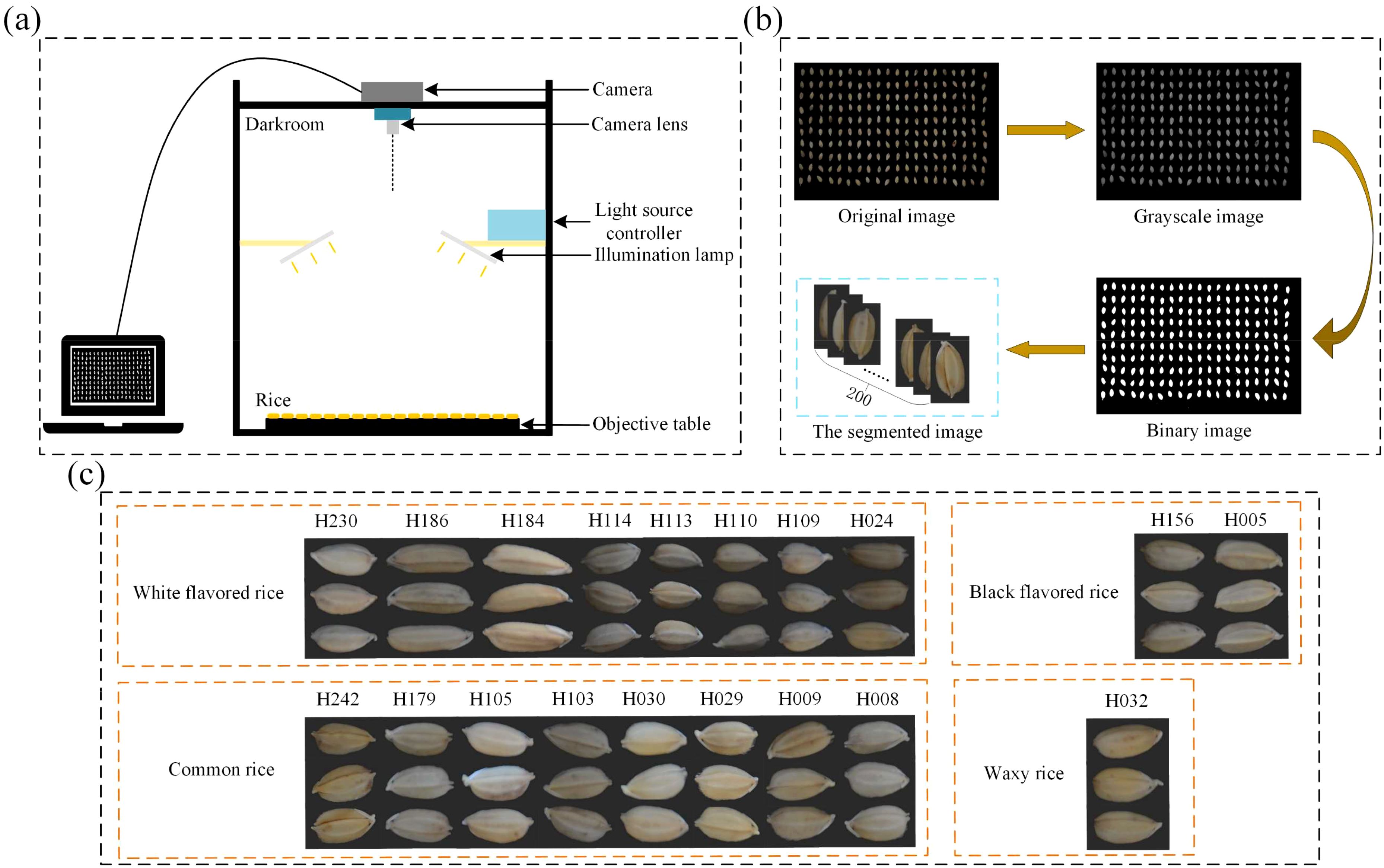
Figure 1. Schematic diagram of the data acquisition process, (A) is the schematic diagram of the imaging system, (B) is the schematic diagram of the process of threshold segmentation, and (C) is the demonstration of the effect of image segmentation.
The process of data preprocessing is shown in Figure 1B. A threshold segmentation method (Al-Amri and Kalyankar, 2010), is used to select an appropriate threshold value to divide the pixels in the image into two categories (target and background), and in this study, the threshold value is set to 0.3, and all the values below 0.3 are set to 0 (black), and all the values above 0.3 are set to 1 (white), and the binary image is obtained based on the grayscale image. The binary image is then multiplied pixel-by-pixel with the original image so that only pixels in the mask image with a value of 1 (representing the target region) are preserved in the original image, while pixels with a value of 0 (representing the background region) are set to black. The edges of the rice seeds are then extracted based on the pixel distributions of the image with the background removed by utilizing the contour extraction algorithm, thus extracting the target region. As shown in Figure 1C, three target images are displayed for each variety, which is divided into four different flavors, and it can be seen that different varieties of rice seeds have very diverse morphologies. In this experiment, useless images need to be eliminated after photographing the seed grains, such as those that are blurred, damaged, or do not meet the experimental requirements at all, which may interfere with the training and evaluation process of the model and cause the model to learn wrong or irrelevant features.
As shown in Table 1, a total of 36735 images are segmented, and then the training set, validation set, and test set are randomly divided according to the ratio of 6:2:2. That is, 22035 images are used for training, 7348 images are used for validation, 7352 images are used for testing, and labeled accordingly.
2.2 Model building
2.2.1 The three convolutions used for the experiment
As shown in Figure 2 is a schematic diagram of the three convolutions used in this study, namely Standard convolution(Conv), Depthwise Convolution(DWConv) or Group Convolution (GConv) (Cohen and Welling, 2016), and Partial Convolution(PConv) (Chen et al., 2023).
Depthwise Convolution/Group Convolution (DWConv/GConv) compensates for some of the drawbacks of Conv by drastically reducing the number of parameters. Since the convolution kernel of DWConv is only convolved for a single channel and does not share weights between different channels, the number of parameters is usually much smaller than that of Conv. This helps to reduce the risk of overfitting and makes the model easier to train. Due to the small number of parameters, DWConv is also faster to compute, so it can build lighter-weight neural network models and reduce the consumption of storage and computational resources, making it suitable for use in scenarios with limited computational resources, such as mobile devices or embedded systems. Meanwhile, since DWConv only performs spatial convolution independently for each channel, its representation ability may be weaker compared to Conv.
Partial Convolution (PConv) is from the model FasterNet, which argues that the main cause of high computation is frequent memory accesses. Figure 2 expresses the design of PConv, which exploits redundancy in feature mapping and systematically applies the Conv on only a portion of the input channels, while the rest of the channels are left unchanged. In essence, PConv has lower FLOPs than Conv and higher FLOPs than DWConv. In other words, PConv makes better use of the computational power on the device, while PConv is also very efficient in extracting spatial features.
The parameters and FLOPs of these three convolutions are shown in Table 2, assuming that the number of input and output channels are and , respectively, is the kernel size of the convolution, G is the size of the group in DWConv/Gconv, and the size of the input data is H×W. is the number of channels used in PConv for spatial feature extraction, and the computation in PConv is only 1/16 of that of Conv in the case of a typical partial ratio of r= / =1/4.
2.2.2 Ghost bottleneck
To improve the performance of the model, Ghost bottleneck was introduced in this experiment. The output feature maps of convolutional layers often contain much redundancy, and some of them could be similar to each other. The authors of GhostNet (Han et al., 2020) point out that it is unnecessary to generate these redundant feature maps one by one with a large number of FLOPs and parameters. Suppose that the output feature maps are “ghosts” of a handful of intrinsic feature maps with some cheap transformations. These intrinsic feature maps are often of smaller size and produced by ordinary convolution filters.
Specifically, given the input data , where c is the number of input channels and h and w are the height and width of the input data, m intrinsic feature maps are generated using a primary convolution:
where is the utilized filters, m is smaller than the output feature map with n channels, and ∗ is the convolution operation. In addition, and are the height and width of the output data, and is the kernel size of convolution filters f. The hyper-parameters such as filter size, stride, and padding, are the same as those in the ordinary convolution to keep the spatial size ( and ) of the output feature maps consistently. To further obtain the desired n feature maps, GhostNet proposes to apply a series of cheap linear operations on each intrinsic feature in Y to generate s ghost features according to the following function:
where is the i-th intrinsic feature map in Y, in the above function is the j-th (except the last one) linear operation for generating the j-th ghost feature map , that is to say, can have one or more ghost feature maps. The last is the identity mapping for preserving the intrinsic feature maps as shown in Figure 3. By utilizing Equation 2, we can obtain n = m · s feature maps Y = [, , · · ·, ] as the output data of a Ghost module as shown in Figure 3. Note that the linear operations operate on each channel whose computational cost is much less than the ordinary convolution.
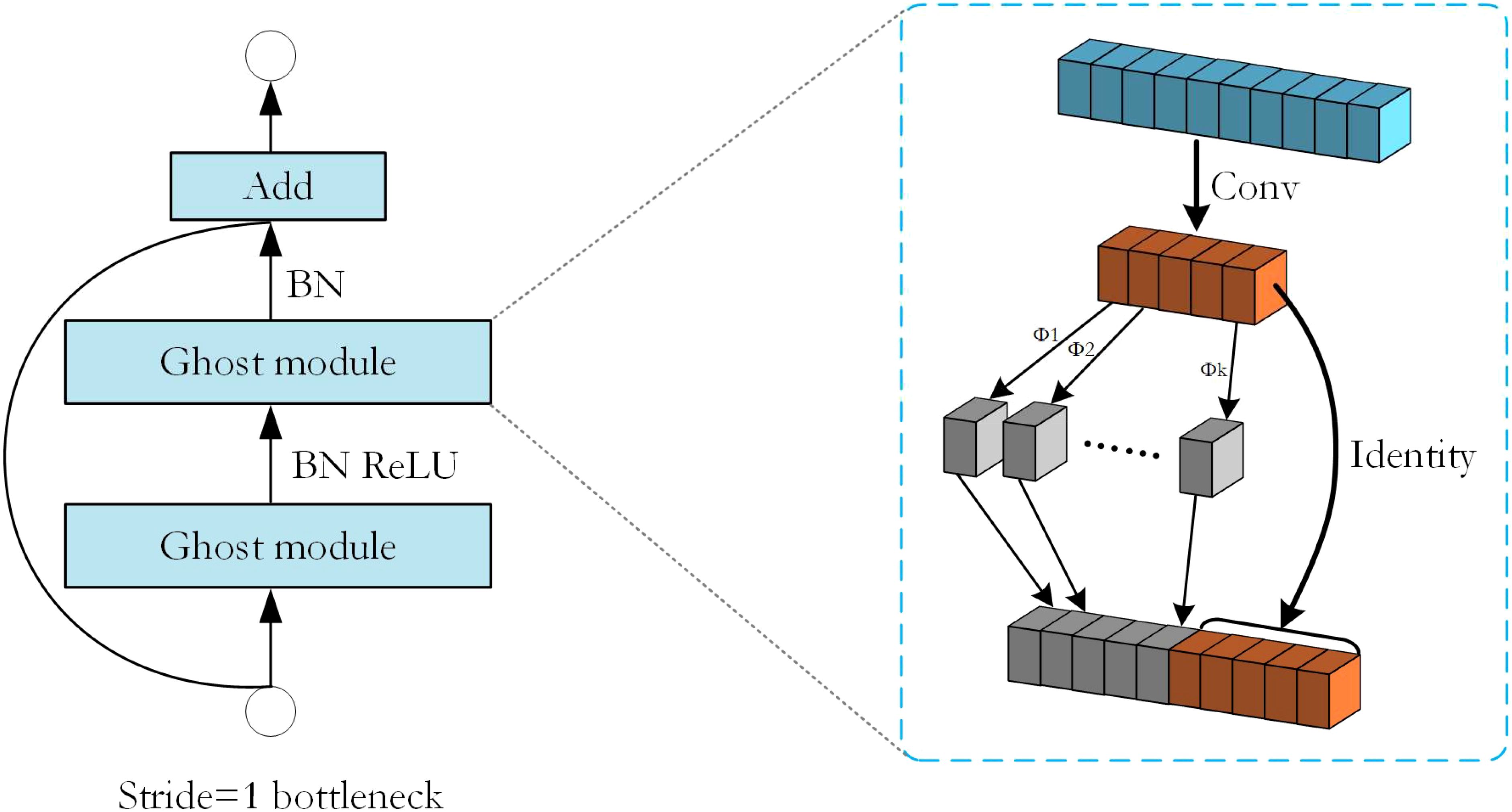
Figure 3. The structure of the Ghost bottleneck with Stride=1 and the structure of the Ghost module inside it.
2.2.3 GeLU activation function and ReLU activation function
The ReLU activation function is a simple and commonly used activation function that sets negative inputs to zero while positive inputs are held constant. Its formula is as follows:
The ReLU activation function introduces a nonlinear property that allows the neural network to learn nonlinear relationships and thus better adapt to complex data patterns. The computation of the ReLU function is very simple, it only needs to compare the inputs and keep the positive values without complex mathematical operations, thus making it suitable for large-scale neural networks. Therefore, the computation is fast and suitable for large-scale neural networks. During training, the ReLU activation function can activate one part of the neurons and set the other part to zero, this sparsity helps to reduce the risk of overfitting and improve the generalization ability of the model.
The GeLU activation function is a smooth and approximate ReLU activation function that adds the properties of a Gaussian error function to ReLU. Its formula is as follows:
The Tanh function is publicized as follows:
The GeLU activation function is a smooth curve with continuity and conductivity, which makes it easier to optimize the neural network during training. In most cases, the GeLU activation function is very close to the ReLU function, so it can retain most of the advantages of ReLU while having smoother properties. The GeLU activation function performs well with noisy data, and its properties based on the Gaussian error function can better deal with the uncertainty in the distribution of the data.
The ReLU activation function is simple and efficient for most deep learning tasks, while the GeLU activation function provides smoother properties while retaining the benefits of ReLU for scenarios that require better robustness. The curves of the ReLU activation function and the GeLU activation function, as well as a comparison of the curves of their derivatives, are shown in Figure 4.

Figure 4. (A) shows the curves of the ReLU activation function and its derivative, and (B) shows the curves of the GeLU activation function and its derivative.
2.2.4 Cross Entropy Loss
The loss function used in this study is Cross Entropy Loss (Zadeh et al., 2020), Cross Entropy Loss is robust to the probability distribution predicted by the model. Even if the model has a small deviation in the predicted probability of some categories, it will not affect the overall loss too much. This makes the model more stable during training and less susceptible to noise or outliers. The binary classification Cross Entropy Loss is shown below:
Where y denotes the sample label and p denotes the probability that the corresponding sample label is predicted to be positive. In the multiclassification task, each sample may have more than one possible category, and the model output is the probability distribution of each sample belonging to each category, Cross Entropy Loss can measure the distance between the probability distribution of the model output and the true labels, to guide the model optimization. The multicategory Cross Entropy Loss formula is shown below:
where denotes the probability that the label is predicted to be c.
2.2.5 FasterNet_T0 and HPFasterNet
The improvement process of the model is shown in Figure 5. To improve the performance of the model and reduce the computation, the main purpose of this study is to replace the 1×1Conv used for upscaling and downscaling with 3×3GConv in the residual structure in FasterNet is to increase the nonlinearity while expanding the receptive field, reducing the number of parameters, and improving the computational efficiency. The 3×3GConv has a higher degree of nonlinearity compared to the 1×1Conv has a higher degree of nonlinearity, which helps the model to learn more complex features and patterns. The 3×3 convolutional kernel has a larger receptive field than the 1×1 convolutional kernel, which means it can capture a wider range of information. In deep neural networks, the size of the receptive field is critical for capturing spatial relationships in an image.
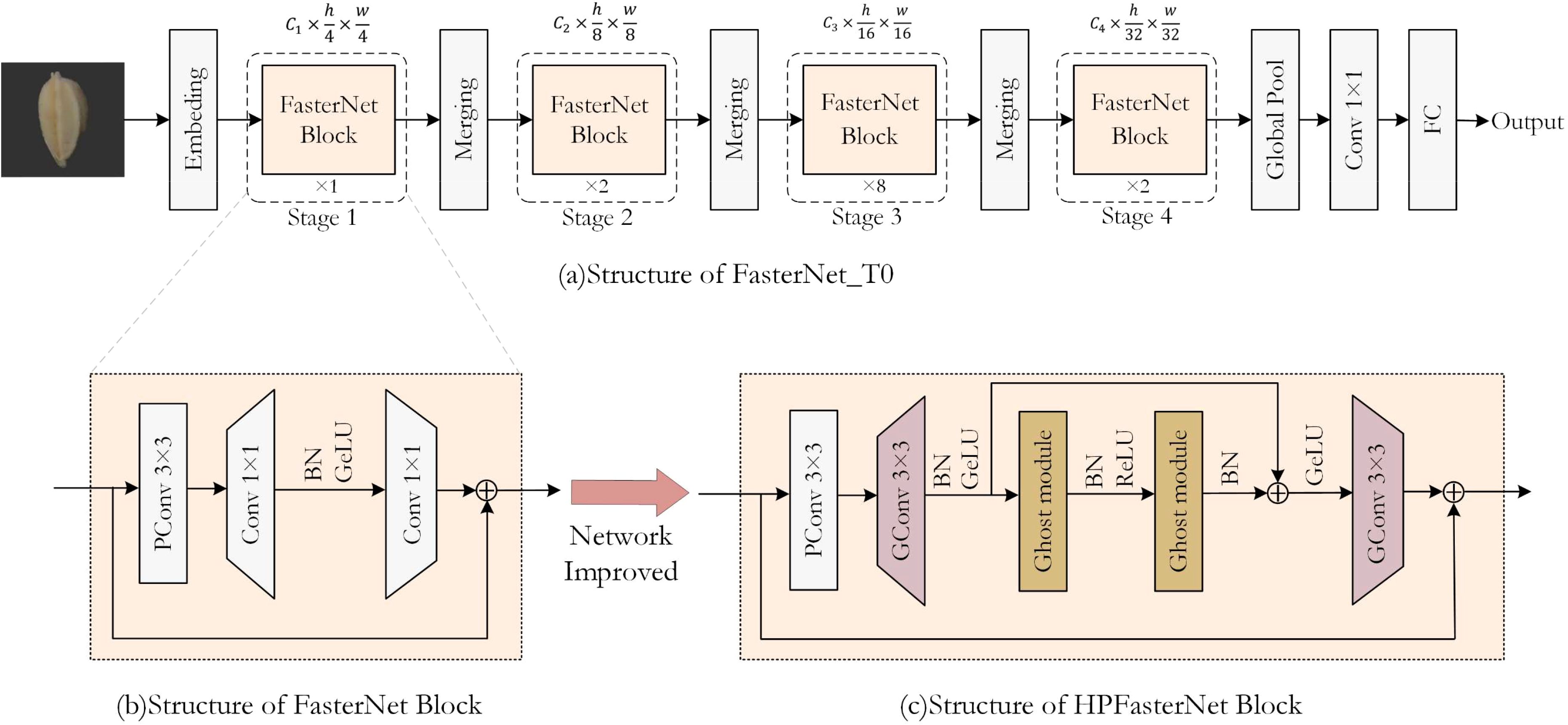
Figure 5. The overall architecture of FasterNet, the structure of FasterNet Block, and the schematic diagram of the modified HPFasterNet Block.
At the same time, this study synthesizes the advantages of FasterNet and GhostNet, and introduces the Ghost bottleneck into the residual structure, so that more and more complex features are extracted through the Ghost bottleneck for the channels that have been amplified. From the overall architecture of the model, it can be seen that the HPFasterNet block is structured as a double residual structure, and the residual block is still nested within the residual structure, and this structure makes the model much more accurate. Although this design leads to a slight increase in the computation and the number of parameters of the model to a certain extent, when introduced in combination with GConv, the number of parameters of the model will be reduced relative to the original model.
2.2.6 Learning rate dynamic adjustment strategy in this study
If the learning rate is set too high or too low, it can have a significant impact on the learning process of the model (Croitoru et al., 2024). If the learning rate is set too high, the advantage is that the model may update the weights faster and thus explore the possible solution space faster. But then, the disadvantage is also obvious that the model may miss the optimal solution because the step size is too large, leading to oscillations or even divergence during the training process, making it difficult to converge to a stable solution. On the contrary, if the learning rate is set too low, although the model can converge more stably, the speed of convergence may be very slow, the advantage is that the model may adjust the weights more finely to get a more accurate solution, but the disadvantage is also obvious, the training process will become very time-consuming, and the model may be more likely to fall into the local optimal solution, and cannot find the global optimal solution. Therefore, it is very important to set the appropriate learning rate, so we choose the gradient decay strategy to dynamically adjust the learning rate during the training process. Its formula is as follows:
is the learning rate of the nth round of model training, is the initial learning rate, d is the decay factor, d=0.85 in this study, n is the current round of model training, p stands for how many rounds decay once, p=4 in this study, represents the downward rounding of , i.e., to take the largest integer that is not larger than integer. In this study, it is called the “8-5 Gradient”.
2.3 Evaluation indexes of model
In the field of machine learning, confusion matrices are often used to compare the results of model classification in supervised learning. Take the binary classification problem as an example, define that the actual result is positive and the predicted result is positive, denoted as TP; if the actual result is negative, the predicted result is positive, denoted as FP; if the actual result is positive, the predicted result is negative, denoted as FN; if the actual result is negative, the predicted result is negative, denoted as TN.
Accuracy (Acc), Precision (P), Recall (R), and F1-score (F1) can be computed from the data in the confusion matrix and used as evaluation metrics for assessing the classification performance of the model.
Accuracy is the ratio of the number of positive and negative samples correctly predicted to the total number of samples, and its formula is:
Precision is the ratio of the number of correctly predicted positive samples to the total number of samples predicted to be positive, and its formula is:
Recall is the ratio of the number of correctly identified positive samples to the total number of actual positive samples, and its formula is:
F1-score is the harmonic mean of precision and recall, and its formula is:
2.4 Training hyperparameter information and experimental environment configuration
This study provides information on the specific experimental parameters used in training the new network model proposed in this paper. In this study, the input size of the dataset is set to 224 × 224, the number of training rounds is 100, the base learning rate is set to 0.01, the Batch size is set to 64, and the optimizer uses SGD. The experiments were deployed on a computer with Intel(R) Xeon(R) Gold 6246R CPU (3.4GHZ) and NVIDIA Quadro RTX 8000 GPU (48GB) having Windows 10 operating system with software configuration installed as Anaconda 3 -2021.11-windows version, using PyCharm compiler and given Pytorch1.2.1 built-in Python3.8.3 programming language, all the algorithms are run in the same environment.
3 Results and discussion
3.1 Impact of learning rate dynamic adjustment strategies on model
To improve the performance of the model, this study first used FasterNet_T0 as the base model and optimized the parameters during the training of the model. As shown in Figure 6A, the trajectory of “8-5 Gradient” during the model training process is demonstrated, with the learning rate reduced every four rounds. Figure 6B shows that comparing “8-5 Gradient” with other representative learning rates, the results show that “8-5 Gradient” obtains the lowest loss and the highest accuracy, which reach 0.383 and 86.72%, respectively, ahead of the other learning rates. This result shows that “8-5 Gradient” has good performance.
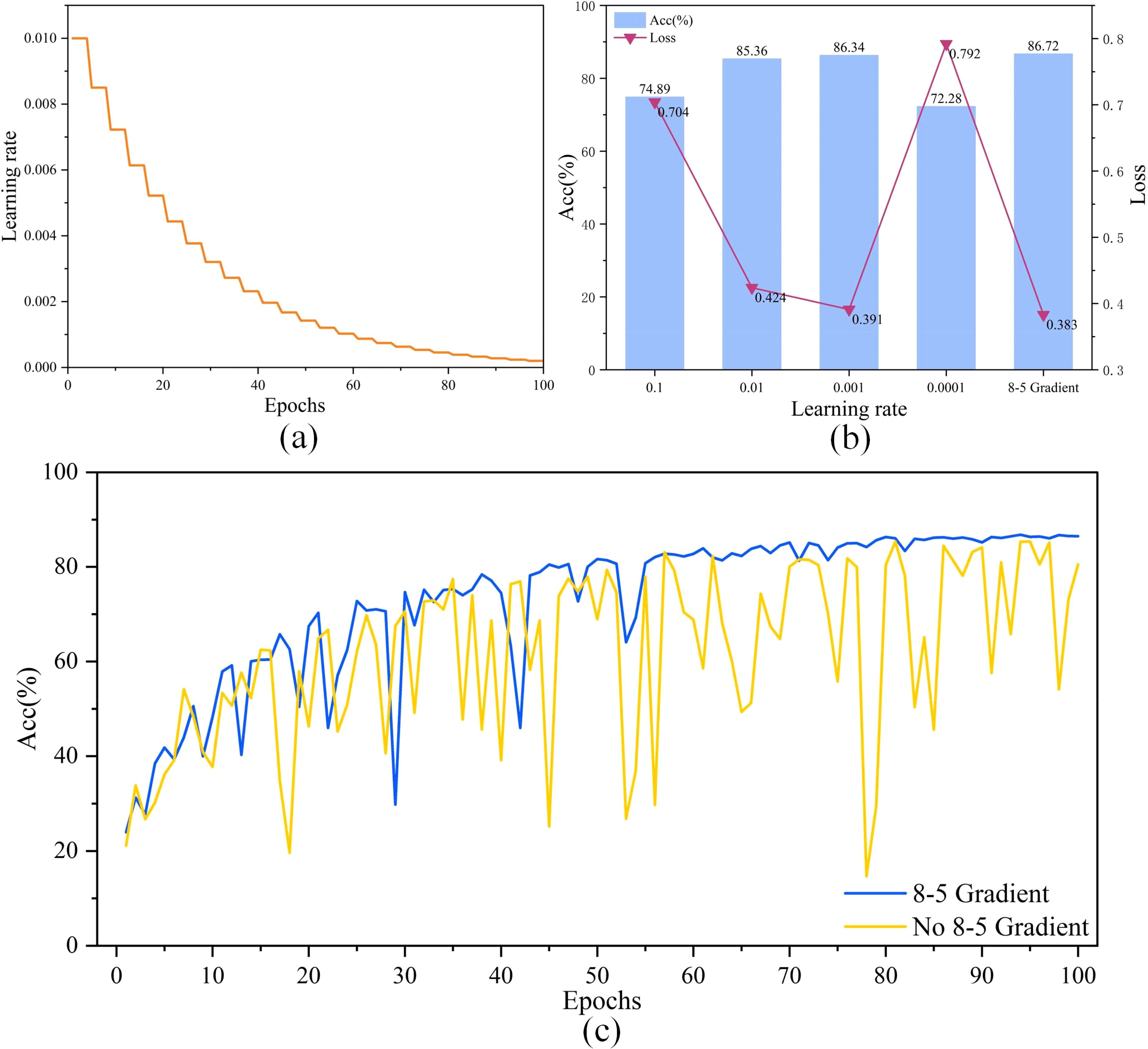
Figure 6. (A) is the trajectory of the learning rate driven by the “8-5 Gradient” during model training, (B) is the results of “8-5 Gradient” compared with other common learning rates, and (C) is the result of comparing the accuracy curves on the validation set after adding the 8-5 gradient and removing the 8-5 gradient.
The accuracy curves of adding an 8-5 Gradient and removing an 8-5 Gradient on the validation set are shown in Figure 6C. The accuracy of the model with an 8-5 Gradient removed fluctuates substantially during the training process, and the convergence and fitting cannot be completed. The model with 8-5 Gradient added, on the other hand, completes the convergence and fitting at the later stage of training, and the accuracy is further improved. This result further proves the advantage of an 8-5 Gradient.
3.2 Results of ablation experiments
This experiment delves into the multidimensional impact of model improvement strategies on overall model performance. The first attempt is to combine FasterNet_T0 with Ghost bottleneck, an improvement that significantly enhances the model’s representational capabilities, thus greatly improving the model’s accuracy from 86.78% to 91.13%. However, this enhancement does not come without a price, it also brings about a significant increase in computational effort, number of parameters, parameter size, and weight size. We replace 1×1Conv with 3×3GConv in the FasterNet_T0 backbone, which reduces the computation by 241.729M and makes the model more lightweight. It is worth noting that this optimization does not sacrifice performance, but instead slightly improves the accuracy of the model. This proves that GConv can significantly reduce the computational load and the number of parameters while maintaining performance. When both GConv and Ghost bottleneck are introduced, the accuracy is drastically improved by 5.22%, while the computational load is reduced by 90.957 M. The specific details of this improvement are shown in Table 3, which fully demonstrates the excellence of HPFasterNet in improving performance and reducing complexity.
3.3 Comparative experiments with other network models
Classical network models are popular for their high accuracy. Lightweight models are widely used in various mobile devices and embedded systems due to their smaller computational resource requirements. To validate the advantages of the network model HPFasterNet proposed in this study, three classical network models [ResNet50 (He et al., 2016), ConvNeXt_T (Liu et al., 2022), and RepVGGNet_A1 (Ding et al., 2021)] and three lightweight network models [GhostNet (Han et al., 2020), ShuffleNet (Zhang et al., 2018), and MobileNetV2 (Sandler et al., 2018)] were compared in this study. The results show that HPFasterNet has significant advantages over the classical network models. The FLOPs(M) of ResNet50, ConvNeXt_T, and RepVggNet_A1 are very large, reaching 4131.734, 4454.781, and 3428.012, respectively, and there is no significant advantage in recognition accuracy, reaching 90.09, 79.40, and 90.25, respectively, which are relatively HPFasterNet is lower. And when comparing other indicators, the classical network models all performed poorly. When comparing lightweight network models, HPFasterNet is slightly higher than ShuffleNet in time complexity and space complexity, but the recognition accuracy of the network model is 2.44% higher than ShuffleNet. Although GhostNet has lower FLOPs(M) relative to HPFasterNet, HPFasterNet has a clear advantage in other metrics. And when compared to MobileNetV2, HPFasterNet’s advantage is even more pronounced, leading MobileNetV2 in all metrics. Taken together, HPFasterNet obtains the optimal overall performance. The specific details are shown in Table 4.
To further validate the advantages of HPFasterNet, the precision, recall, and F1 scores of the six network models were visually compared with HPFasterNet in this study, as shown in Figure 7. The precision, recall, and F1-scores of the six network models are not as good as HPFasterNet, with ConvNeXt_T having the worst performance, with precision, recall and F1-scores of 79.49%, 79.52% and 79.3%, respectively. Overall, among the six network models, HPFasterNet had the best recognition results.
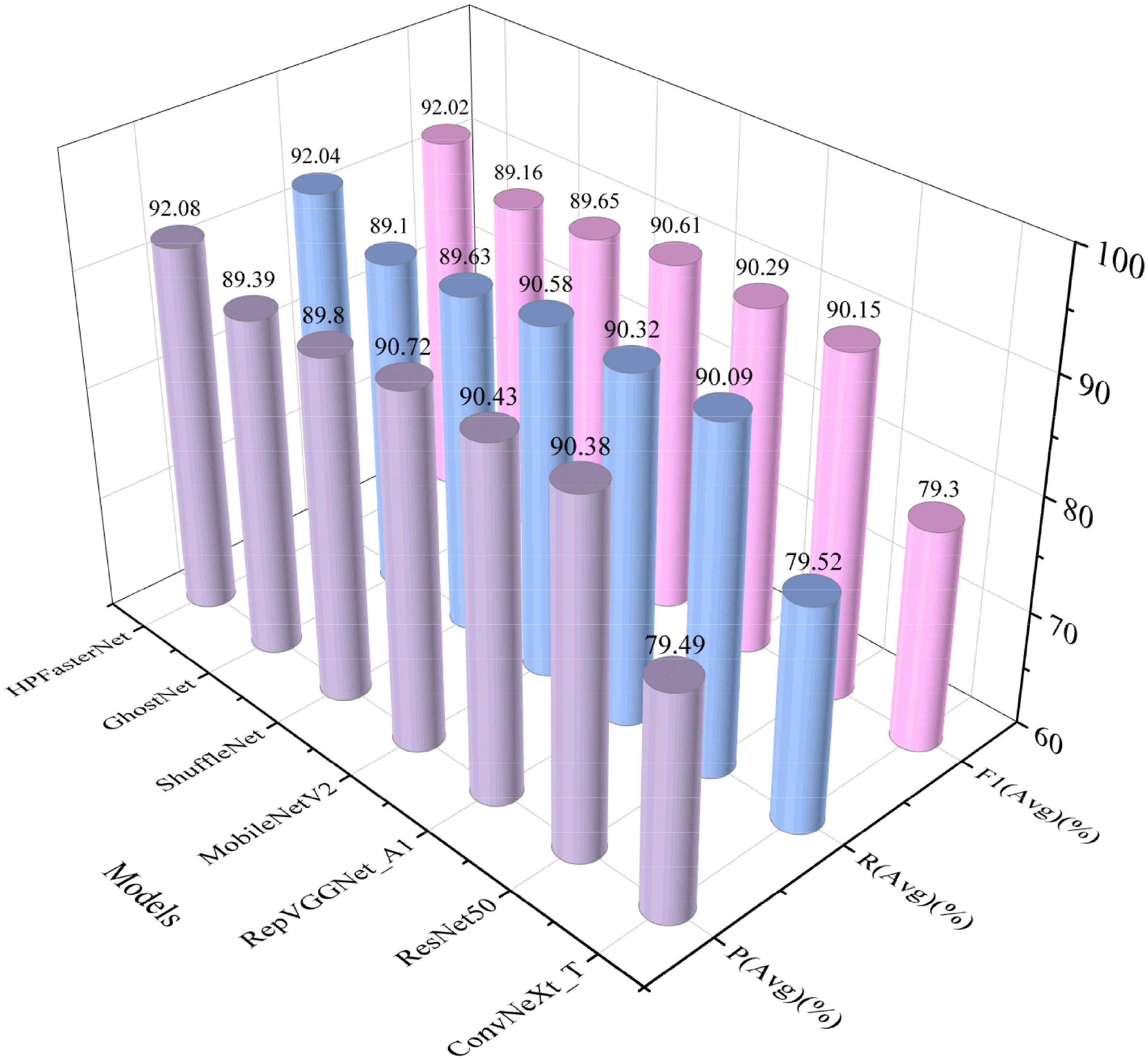
Figure 7. Comparison results of HPFasterNet with other network models in terms of precision, recall, and F1-score.
3.4 Before and after model improvement
To evaluate the performance of the model more comprehensively, the comparative analysis of the confusion matrix before and after the model improvement was plotted in this study to reflect the actual recognition of each variety by FasterNet_T0 and HPFasterNet. As shown in Figure 8, before the improvement, due to the limited ability of FasterNet_T0 for feature extraction and the similarity of features among different varieties of rice, the error of some varieties is large, such as H003 and H008, which is easy to misclassify. While the improved model can reduce the misclassification to a certain extent, the values on the diagonal line are also significantly improved with darker colors, which indicates that the recognition rate of the model on each category has been significantly improved. In addition, the overall structure of the confusion matrix has become clearer, with a higher degree of differentiation between categories. Overall, the improved model demonstrated better performance on the classification task, providing more reliable and accurate classification results for related applications.
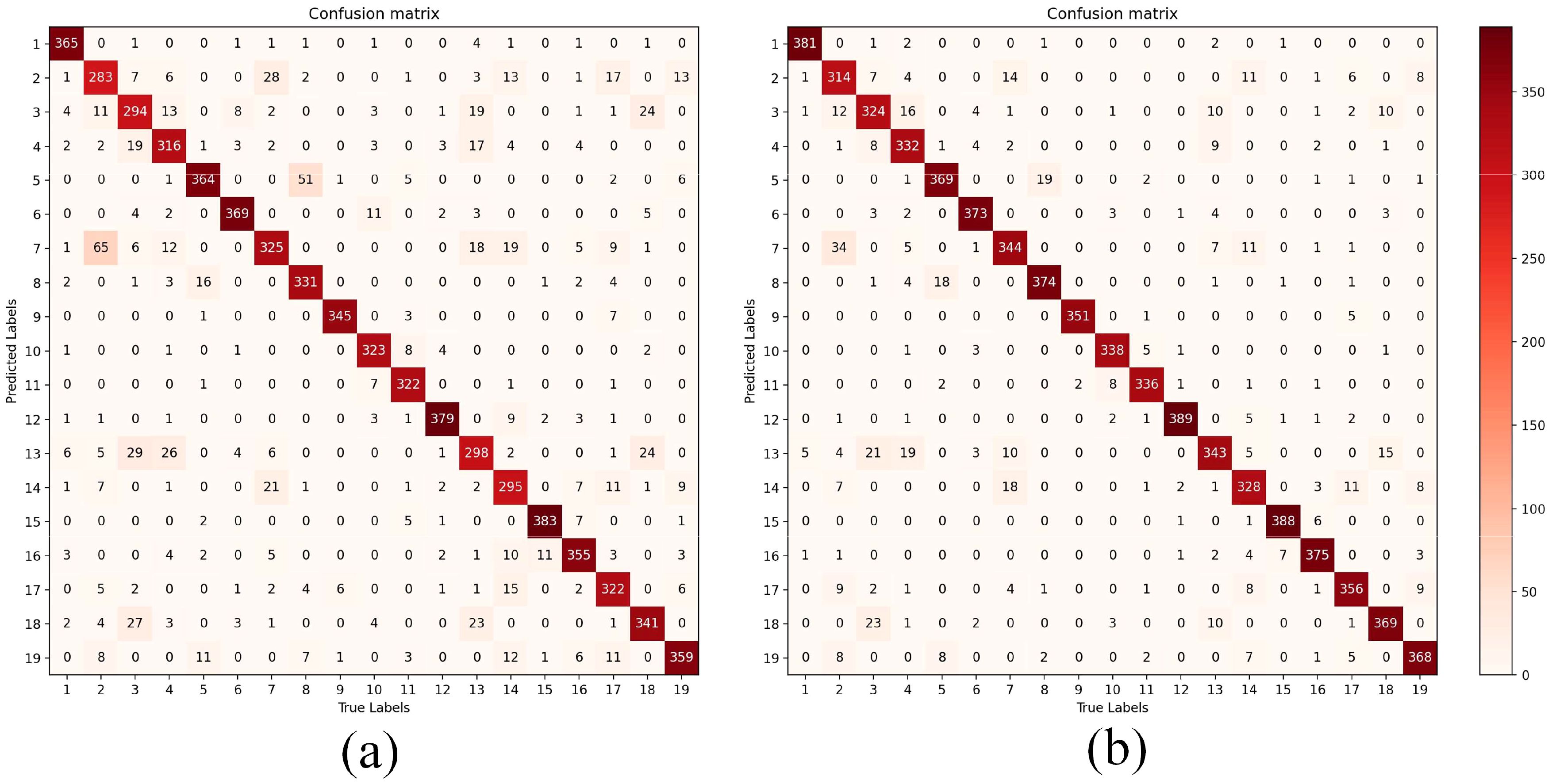
Figure 8. Confusion matrix before and after model improvement, (A) is the confusion matrix of FasterNet_T0 in the test set, (B) is the confusion matrix of HPFasterNet in the test set.
As shown in Table 5, based on the confusion matrix, a comparison of each category before and after the improvement in terms of precision, recall, and F1 score can be derived. The precision before improvement varies widely between categories, and it is worth noting that certain categories have relatively low precision. After model improvement, the precision of all the categories is improved, especially on the categories that had lower precision before. For example, on H032, the accuracy before the improvement was 70.5%, while after the improvement it increased to 85.1%. This means that 85.1% of the samples predicted by the model as H032 belong to H032, a significant improvement over the 70.5% before the improvement. Similarly, for each category, the recall before improvement varies. After the model improvement, the recall of all categories is improved, especially on the categories with lower recall than before, the improvement is more significant. In the case of H114, for example, the recall before improvement is 76.6%, while after improvement it increases to 88.2%. This means that 88.2% of all samples that belong to H114 are correctly predicted as H114 by the model, which is a significant improvement compared to 76.6% before the improvement. After model improvement, the F1-scores of all categories are improved, especially on the categories with lower F1-scores before, the improvement is more significant. In the case of H008, for example, the F1 score before the improvement is 73.9%, while after the improvement it increases to 83.0%. This indicates that the comprehensive performance of the model on H008 has been effectively improved, both in terms of precision and recall. The experiments show that after the model improvement, the performance of all the categories is improved in terms of precision, recall, and F1 score. This indicates that the classification ability of the model has been effectively enhanced to better accommodate the differences between the different categories.
The F1-score is the reconciled average of precision and recall, which is used to comprehensively evaluate the performance of the model. Before improvement, the F1-score varies as precision and recall vary between categories. To further assess the comprehensive performance of the model before and after the model improvement, this study visualized and compared the model’s F1-scores in each category, as shown in Figure 9. From the figure, it can be seen more clearly that the F1-scores between the categories of the model before the improvement are more different and the model has a poorer recognition ability after the model improvement is completed, the F1-scores of each category are improved, and presents a more balanced distribution, and the differences between the categories become smaller. This result indicates that the overall performance of the model has been significantly improved, and the adaptability and generalization ability of the model in each category has been enhanced. For some categories with lower recognition accuracy before improvement (e.g., category 2, category 3, category 7, and category 13), the model gives more attention and optimization, which results in a significant increase in their recognition accuracy after improvement, so that the overall performance of the model as a whole has been substantially improved.
Figure 10 shows the loss curve and accuracy curve on the validation set before and after the model improvement. The accuracy curve before model improvement still has large fluctuations in the pre-training period, but then the growth rate gradually slows down and stabilizes at the end of the training period. Although a relatively stable level of accuracy can eventually be achieved through the 8-5 Gradient model, the model still has large fluctuations in the early stages of training, and there is an overall risk of overfitting. In contrast, the accuracy curve of the improved model shows a more obvious upward trend, and the accuracy rises rapidly in the early stage of training, and then continues to maintain a stable growth trend, eventually reaching the highest accuracy level and stabilizing. Meanwhile, the loss curve of the model before improvement fluctuates greatly in the early stage of training, but gradually flattens out in the late stage of training, indicating that the model encounters optimization difficulties during training and the loss is difficult to be further reduced. In addition, the higher final value of the loss curve indicates that the model has limited fitting ability and may have overfitting or underfitting problems, while the improved loss curve shows a more desirable downward trend. Ultimately, the smaller the value of the loss curve, means that the fitting ability of the model is significantly improved and can better adapt to the training data. By comparing the loss curves and accuracy curves before and after the improvement, we can see that the optimization ability and accuracy of the improved model have been significantly improved.
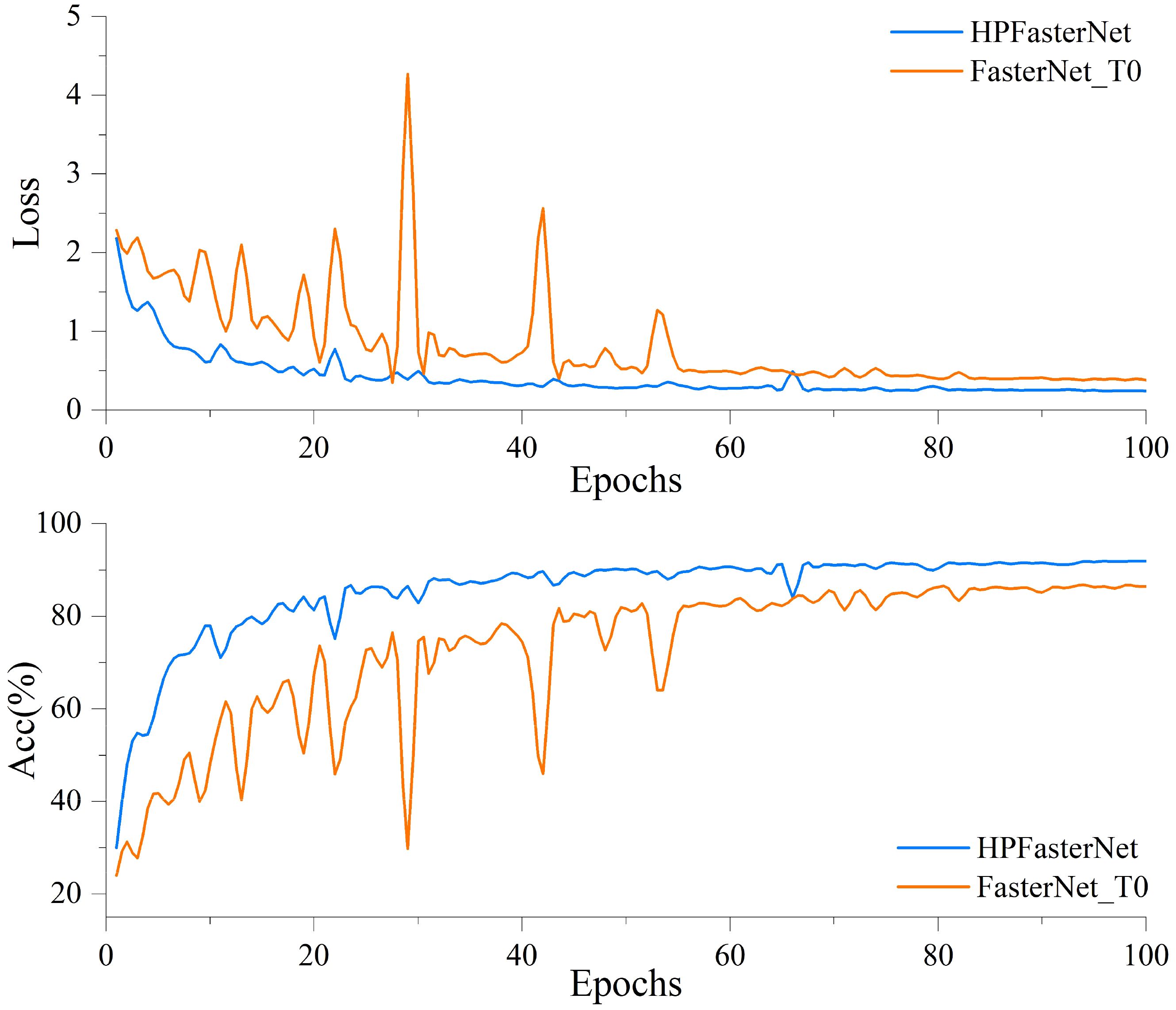
Figure 10. Comparison of loss curves and accuracy curves on the validation set before and after model improvement.
3.5 Test results of rice seeds with different flavors
The following experiments were done to verify the effectiveness of the network model proposed in this study for the recognition of rice with different flavors. As shown in Figure 11, comparing the confusion matrices of the models in the experiment, when comparing the confusion matrices of the other six models, it can be noticed that each model performs differently on the classification task. Looking at the confusion matrix of HPFasterNet, we can see that the values on the diagonal line are relatively high, which means that the model performs well in correctly classifying flavored rice. The higher values on the diagonal line indicate that the model has a higher prediction accuracy for the corresponding category. Meanwhile, relatively low values on the off-diagonal line mean that the model misclassified samples to other categories less often. In contrast, the confusion matrices of the other six models show different degrees of variation. The lower values on the diagonal of the confusion matrices of the other models relative to HPFasterNet indicate that they are not as accurate as HPFasterNet on the classification task. This result suggests that the improved model has a clear advantage in classification performance.
The accuracy, precision, recall, and F1-scores of each network model on different flavored rice were derived from the confusion matrix, and as shown in Table 6, the accuracy, precision, recall, and F1-scores of HPFasterNet reached 98.98%, 99.00%, 98.95%, and 98.93%, respectively. The results show that HPFasterNet outperforms the other six network models, and it can be concluded that the network model proposed in this study shows excellent performance in flavored rice recognition.
4 Conclusions
This study delves into the application of the improved lightweight network HPFasterNet in the field of rice, especially in classifying and recognizing rice seeds of different varieties. We make important improvements to the traditional FasterNet_T0 model by introducing efficient feature extraction modules Ghost bottleneck and GConv. These innovations not only significantly improve the model’s accuracy in classifying rice seed grains by 5.22%, but also dramatically reduce the computational complexity and the number of parameters, making HPFasterNet an ideal choice for resource-constrained environments. In the comparison experiments, we selected three classical network models and three lightweight network models as references. Through exhaustive performance evaluation and comparative analysis, we find that HPFasterNet demonstrates significant advantages in several key metrics. HPFasterNet can accurately distinguish rice seeds of different varieties, which is mainly attributed to its powerful feature extraction capability and optimization strategy. This feature information is fully utilized by the model, thus achieving high-precision and fast classification recognition. The experimental results also show that HPFasterNet can accurately capture the subtle differences between different flavored rice, and can accurately differentiate between different flavored rice with an accuracy of 98.98%.
However, despite the results achieved in this study, we are aware of some limitations. First, due to the diversity of rice varieties and the complexity of growing environments, existing feature extraction and classification methods may not be able to fully cover all situations. Although HPFasterNet has adopted advanced techniques such as partial convolution (PConv) to improve performance, more efficient network structures, such as the introduction of attention mechanism, deformable convolution, etc., can be further explored in the future to enhance the model’s ability to extract features from rice seeds. To meet the real-time and low-power requirements in practical applications, it is possible to investigate how to further reduce the size and computational complexity of the model with guaranteed accuracy, e.g., through model pruning and quantization. Consider combining rice seed classification with other related tasks (e.g., seed counting, pest and disease detection, etc.) to improve the model’s generalization ability and practicality through multi-task learning. To improve the performance and generalization ability of the algorithm, it is necessary to construct a larger and more diverse rice seed dataset, including seed images of different varieties, different growth stages, and different light conditions.
HPFasterNet can be used for crop monitoring and management in precision agriculture, e.g., by real-time monitoring of rice growth and seed yield, it can provide farmers with precise suggestions for irrigation and fertilization. Combined with other image processing technologies, HPFasterNet can be further applied to early warning and control of pests and diseases to improve crop yield and quality. In the food processing industry, HPFasterNet can be used to classify and detect food ingredients, such as distinguishing different varieties of rice, to ensure the quality and safety of food. By recording and analyzing key information in the food production process, HPFasterNet can assist in realizing food traceability and tracking, and improve the efficiency of food safety management. In ecology, HPFasterNet can be used to categorize and monitor plant populations, helping to understand changes and trends in biodiversity. By monitoring and analyzing plant growth, HPFasterNet can indirectly reflect the health of the environment and provide the scientific basis for environmental protection and governance.
Data availability statement
The original contributions presented in the study are included in the article/supplementary material. Further inquiries can be directed to the corresponding author.
Author contributions
HY: Conceptualization, Funding acquisition, Investigation, Project administration, Supervision, Validation, Writing – review & editing. ZC: Conceptualization, Data curation, Formal analysis, Software, Validation, Visualization, Writing – original draft. SS: Funding acquisition, Methodology, Project administration, Resources, Supervision, Validation, Writing – review & editing. CQ: Methodology, Supervision, Visualization, Writing – review & editing. JL: Formal analysis, Supervision, Visualization, Writing – review & editing. CY: Formal analysis, Supervision, Visualization, Writing – review & editing.
Funding
The author(s) declare financial support was received for the research, authorship, and/or publication of this article. This research was funded by the National Key R&D Program of China (2022YFD2001602) and the Natural Science Foundation of Jilin Province (YDZJ202101ZYTS148). This work was also supported in part by the Jilin Provincial Department of Science and Technology (20220202032NC).
Acknowledgments
We thank the Rice Research Institute of Jilin Academy of Agricultural Sciences for rice data support and the Smart Agriculture Research Institute of Jilin Agricultural University for equipment support. We thank the reviewers for their valuable suggestions.
Conflict of interest
The authors declare that the research was conducted in the absence of any commercial or financial relationships that could be construed as a potential conflict of interest.
Generative AI statement
The author(s) declare that no Generative AI was used in the creation of this manuscript.
Publisher’s note
All claims expressed in this article are solely those of the authors and do not necessarily represent those of their affiliated organizations, or those of the publisher, the editors and the reviewers. Any product that may be evaluated in this article, or claim that may be made by its manufacturer, is not guaranteed or endorsed by the publisher.
References
Al-Amri, S. S., Kalyankar, N. V. J. (2010). Image segmentation by using threshold techniques. doi: 10.48550/arXiv.1005.4020
Bi, C., Hu, N., Zou, Y., Zhang, S., Xu, S., Yu, H. J. A. (2022). Development of deep learning methodology for maize seed variety recognition based on improved swin transformer. Agronomy-Basel. 12, 1843. doi: 10.3390/agronomy12081843
Chen, J., Kao, S. H., He, H., Zhuo, W., Wen, S., Lee, C.-H., et al. (2023). “Run, Don’t walk: Chasing higher FLOPS for faster neural networks,” in Proceedings of the IEEE/CVF conference on computer vision and pattern recognition, 12021–12031. Available online at: https://www.arxiv.org/abs/2303.03667v1.
Chen, M. Y., Chen, Z. X., Luo, L. F., Tang, Y. C., Cheng, J. B., Wei, H. L., et al. (2024). Dynamic visual servo control methods for continuous operation of a fruit harvesting robot working throughout an orchard. Comput. Electron. Agric. 219, 16. doi: 10.1016/j.compag.2024.108774
Cohen, T., Welling, M. (2016). “Group equivariant convolutional networks,” in International conference on machine learning (PMLR), 2990–2999. Available online at: https://www.arxiv.org/abs/1602.07576v3
Cong, S., Zhou, Y. (2023). A review of convolutional neural network architectures and their optimizations. Artif. Intell. Rev. 56, 1905–1969. doi: 10.1007/s10462-022-10213-5
Creppy, P., Bicknell, K., Renwick, A. J. E. A. (2024). Understanding smallholder preferences for joint ventures in Ghana’s rice sector: Improving market access through inclusive business models. Economic Analysis Policy. 81, 470–481. doi: 10.1016/j.eap.2023.12.011
Croitoru, F. A., Ristea, N. C., Ionescu, R. T., Sebe, N. (2024). Learning rate curriculum. Int. J. Comput. Vis. 133, 291–314. doi: 10.1007/s11263-024-02186-5
Ding, X., Zhang, X., Ma, N., Han, J., Ding, G., Sun, J. (2021). “Repvgg: Making vgg-style convnets great again,” in Proceedings of the IEEE/CVF conference on computer vision and pattern recognition, 13733–13742. Available online at: https://www.arxiv.org/abs/2101.03697v3.
Ge, Y. F., Song, S. Z., Yu, S., Zhang, X. L., Li, X. F. (2024). Rice seed classification by hyperspectral imaging system: A real-world dataset and a credible algorithm. Comput. Electron. Agric. 219, 13. doi: 10.1016/j.compag.2024.108776
Han, K., Wang, Y., Tian, Q., Guo, J., Xu, C., Xu, C. (2020). “Ghostnet: More features from cheap operations,” in Proceedings of the IEEE/CVF conference on computer vision and pattern recognition, 1580–1589. Available online at: https://www.arxiv.org/abs/1911.11907v2.
He, K., Zhang, X., Ren, S., Sun, J. (2016). Identity mappings in deep residual networks. Arxiv. doi: 10.48550/arXiv.1603.05027
Jin, B. C., Zhang, C., Jia, L. Q., Tang, Q. Z., Gao, L., Zhao, G. W., et al. (2022). Identification of rice seed varieties based on near-infrared hyperspectral imaging technology combined with deep learning. ACS Omega 7, 4735–4749. doi: 10.1021/acsomega.1c04102
Joshi, D., Butola, A., Kanade, S. R., Prasad, D. K., Mithra, S. A., Singh, N., et al. (2021). Label-free non-invasive classification of rice seeds using optical coherence tomography assisted with deep neural network. Optics Laser Technol. 137, 106861. doi: 10.1016/j.optlastec.2020.106861
Koklu, M., Cinar, I., Taspinar, Y. S. (2021a). Classification of rice varieties with deep learning methods. Comput. Electron. Agric. 187, 8. doi: 10.1016/j.compag.2021.106285
Koklu, M., Cinar, I., Taspinar, Y. S. J. C., Agriculture, E.I (2021b). Classification of rice varieties with deep learning methods. Computers Electronics Agriculture 187, 106285. doi: 10.1016/j.compag.2021.106285
Li, H. W., Gu, Z. N., He, D. Q., Wang, X. C., Huang, J. D., Mo, Y. M., et al. (2024). A lightweight improved YOLOv5s model and its deployment for detecting pitaya fruits in daytime and nighttime light-supplement environments. Comput. Electron. Agric. 220, 21. doi: 10.1016/j.compag.2024.108914
Liu, Z., Mao, H., Wu, C.-Y., Feichtenhofer, C., Darrell, T., Xie, S. (2022). “A convnet for the 2020s,” in Proceedings of the IEEE/CVF conference on computer vision and pattern recognition, (These CVPR 2022 papers are the Open Access versions). 11976–11986.
Lu, S., Bai, X., Li, W., Wang, N. J. T. F., Change, S. (2019). Impacts of climate change on water resources and grain production 143, 76–84. doi: 10.1016/j.techfore.2019.01.015
Patrício, D. I., Rieder, R. (2018). Computer vision and artificial intelligence in precision agriculture for grain crops: A systematic review. Comput. Electron. Agric. 153, 69–81. doi: 10.1016/j.compag.2018.08.001
Qaim, M. (2020). Role of new plant breeding technologies for food security and sustainable agricultural development. Appl. Econ. Perspect. Policy 42, 129–150. doi: 10.1002/aepp.13044
Qi, H. N., Huang, Z. H., Sun, Z. Y., Tang, Q. Z., Zhao, G. W., Zhu, X. H., et al. (2023). Rice seed vigor detection based on near-infrared hyperspectral imaging and deep transfer learning. Front. Plant Sci. 14, 13. doi: 10.3389/fpls.2023.1283921
Sandler, M., Howard, A., Zhu, M., Zhmoginov, A., Chen, L.-C. (2018). “Mobilenetv2: Inverted residuals and linear bottlenecks,” in Proceedings of the IEEE conference on computer vision and pattern recognition, 4510–4520. Available online at: https://www.arxiv.org/abs/1801.04381v4.
Tulbure, A. A., Tulbure, A. A., Dulf, E. H. (2022). A review on modern defect detection models using DCNNs - Deep convolutional neural networks. J. Adv. Res. 35, 33–48. doi: 10.1016/j.jare.2021.03.015
Verma, D. K., Srivastav, P. P. (2020). Bioactive compounds of rice (Oryza sativa L.): Review on paradigm and its potential benefit in human health. Trends Food Sci. Technol. 97, 355–365. doi: 10.1016/j.tifs.2020.01.007
Verma, V., Vishal, B., Kohli, A., Kumar, P. P. (2021). Systems-based rice improvement approaches for sustainable food and nutritional security. Plant Cell Rep. 40, 2021–2036. doi: 10.1007/s00299-021-02790-6
Xie, S., Girshick, R., Dollár, P., Tu, Z., He, K. (2017). “Aggregated residual transformations for deep neural networks,” in Proceedings of the IEEE conference on computer vision and pattern recognition, 1492–1500. Available online at: https://www.arxiv.org/abs/1611.05431v2.
Yu, H. L., Chen, Z. Y., Song, S. Z., Chen, M. J., Yang, C. L. (2024). Classification of rice seeds grown in different geographical environments: an approach based on improved residual networks. Agronomy-Basel 14, 24. doi: 10.3390/agronomy14061244
Zadeh, S. G., Schmid, M. J. I., Intelligence, M (2020). Bias in cross-entropy-based training of deep survival networks. IEEE transactions on pattern analysis and machine intelligence. 43, 3126–3137. doi: 10.1109/TPAMI.2020.2979450
Zareiforoush, H., Minaei, S., Alizadeh, M. R., Banakar, A. (2015). Potential applications of computer vision in quality inspection of rice: A review. Food Eng. Rev. 7, 321–345. doi: 10.1007/s12393-014-9101-z
Zhang, X., Zhou, X., Lin, M., Sun, J. (2018). “Shufflenet: An extremely efficient convolutional neural network for mobile devices,” in Proceedings of the IEEE conference on computer vision and pattern recognition, 6848–6856. Available online at: https://www.arxiv.org/abs/1707.01083v2
Keywords: rice seed classification, japonica rice, deep learning, different flavored rice, lightweight network
Citation: Yu H, Chen Z, Song S, Qi C, Liu J and Yang C (2025) Rapid and non-destructive classification of rice seeds with different flavors: an approach based on HPFasterNet. Front. Plant Sci. 15:1502631. doi: 10.3389/fpls.2024.1502631
Received: 27 September 2024; Accepted: 26 December 2024;
Published: 20 January 2025.
Edited by:
Junfeng Gao, University of Lincoln, United KingdomReviewed by:
Jing Yu, Chinese Academy of Sciences (CAS), ChinaXiangjun Zou, South China Agricultural University, China
Copyright © 2025 Yu, Chen, Song, Qi, Liu and Yang. This is an open-access article distributed under the terms of the Creative Commons Attribution License (CC BY). The use, distribution or reproduction in other forums is permitted, provided the original author(s) and the copyright owner(s) are credited and that the original publication in this journal is cited, in accordance with accepted academic practice. No use, distribution or reproduction is permitted which does not comply with these terms.
*Correspondence: Shaozhong Song, c29uZ3N6QGpsZW51LmVkdS5jbg==
 Helong Yu
Helong Yu Zhenyang Chen
Zhenyang Chen Shaozhong Song
Shaozhong Song Chunyan Qi4
Chunyan Qi4